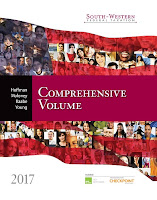Search This Blog
Chapter 11 Investor Losses
Discussion Questions
1. LO.1, 2, 3 Identify two provisions designed to limit the tax benefits a taxpayer may obtain from a tax shelter investment. Describe how these rules reduce or defer the recognition of tax losses.
2. LO.2 List some events that increase or decrease an investor’s at-risk amount. What are some strategies that a taxpayer can employ to increase the at-risk amount to claim a higher deduction for losses?
3. LO.2, 3 Roberto invested $18,000 in a chicken production operation. Using nonrecourse notes, the business purchases $120,000 worth of grain to feed the chickens. If Roberto’s share of the expense is $26,000, how much can he deduct?
4. LO.3 Explain the meaning of the terms active income, portfolio income, and passive activity income.
5. LO.3 Carlos owns an interest in an activity that produces a $100,000 loss during the year. Would he prefer to have the activity classified as active or passive?
Explain.
6. LO.3 Kim owns an interest in an activity that produces $100,000 of income during the year. Would Kim prefer to have the activity classified as active or passive?
Discuss.
7. LO.3 Upon a taxable disposition of a passive activity, the taxpayer can utilize any suspended losses and credits related to that activity. Do you agree? Explain.
8. LO.3 Discuss whether the passive activity loss rules apply to the following: individuals, closely held C corporations, S corporations, partnerships, and personal service corporations.
9. LO.3 Bronze Corporation has $100,000 of active income, $55,000 of portfolio income, and a $55,000 passive activity loss. Under what circumstances is
Bronze prohibited from deducting the loss? Allowed to deduct the loss?
10. LO.4 Discuss what constitutes a passive activity.
11. LO.5 What is the significance of the term material participation? Why is the extent of a taxpayer’s participation in an activity important in determining whether a loss from the activity is deductible or nondeductible?
12. LO.5 How many hours must a participant work in a nonrental activity to be guaranteed material participation status?
13. LO.5 Suzanne owns interests in a bagel shop, a lawn and garden store, and a convenience store. Several full-time employees work at each of the enterprises. As of the end of November of the current year, Suzanne has worked 150 hours in the bagel shop, 250 hours at the lawn and garden store, and 70 hours at the convenience store. In reviewing her financial records, you learn that she has no passive investments that are generating income and that she expects these three ventures collectively to produce a loss. What recommendation would you offer Suzanne as she plans her activities for the remainder of the year?
14. LO.5, 11 John, an engineer, operates a separate business that he acquired eight years ago. If he participates 85 hours in the business and it incurs a loss of $34,000, under what circumstances can John claim an active loss?
15. LO.2, 3, 5 Rita retired from public accounting after a long and successful career of
45 years. As part of her retirement package, she continues to share in the profits and losses of the firm, albeit at a lower rate than when she was working fulltime.
Because Rita wants to stay busy during her retirement years, she has invested and works in a local hardware business, operated as a partnership. Unfortunately, the business has recently gone through a slump and has not been generating profits.
Identify relevant tax issues for Rita.
16. LO.5 Some types of work are counted in applying the material participation standards, and some types are not counted. Discuss and give examples of each type.
17. LO.5 Last year Alan’s accountant informed him that he could not claim any of his passive activity losses on his income tax return because of his lack of material participation. To circumvent the tax problem this year, Alan tells his wife that she may have to put in some time at the various businesses. Identify the tax issues that
Alan faces.
18. LO.5 Sean, a limited partner in Ivy Nursery, is informed that his portion of the entity’s current loss is $18,000. As a limited partner, can Sean assume that his share of the partnership loss is a passive activity loss? Explain.
19. LO.6 Explain why some rental activities may not be treated as such under the passive activity loss rules.
20. LO.3, 4, 5, 6 How is passive activity defined in the Code? What aspects of the definition have been clarified by final or Temporary Regulations?
21. LO.8 What is a real estate professional? Why could qualifying for this status be beneficial under the passive activity loss rules?
22. LO.8 Caroline owns a real estate rental activity that produces a loss of $65,000 during the current year. Under what circumstances can Caroline treat the entire loss as nonpassive?
23. LO.8 Since his college days, Charles has developed an entrepreneurial streak. After working in his family’s grocery business, he starts several ventures on his own.
Even though Charles is independently wealthy, he is looking forward to working in each of the ventures. He plans to “drop in” on the businesses from time to time between personal trips to Europe and the Caribbean. As of the end of the year, he has established computer software stores in Dayton (Ohio), Austin, and Seattle; bagel bakeries in Albany, Athens (Georgia), and Tallahassee; and mountain bike and ski rental shops in small towns in Vermont, West Virginia, Colorado, and California. Identify the tax issues facing Charles.
24. LO.8 Brad owns a small townhouse complex that generates a loss during the year.
Under what circumstances can Brad deduct a loss from the rental activity?
What limitations apply?
25. LO.8 In connection with passive activities, what is a deduction equivalent and how is it computed?
26. LO.10 What is investment interest expense? Describe the basic rules that may limit its deductibility.
